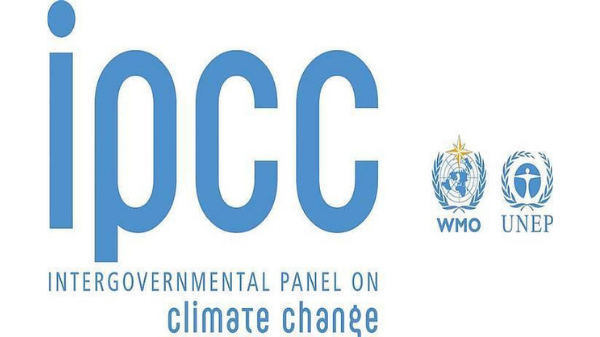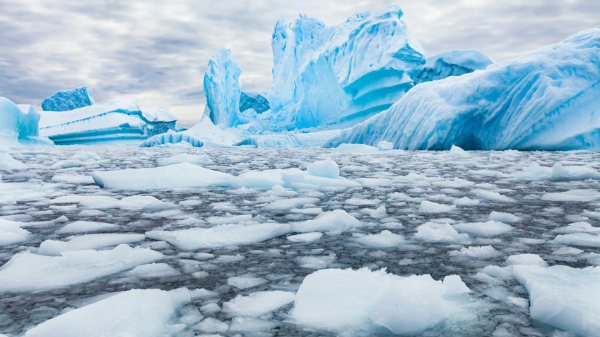YOU SHOULD SUBSCRIBE TO CLIMATE CHANGE WEEKLY.
IN THIS ISSUE:
- Democrats Can’t Solve Energy-Related Problems Because They Don’t Understand They Are Causing Them
- Podcast of the Week: Hot Talk, Cold Science: The Truth About the State of Climate Science in its Public Portrayal (Guest: David Legates, Ph.D.)
- IPCC Report Misrepresents Climate Data
- Antarctic Sea Ice Is Consistently Expanding Amidst Warming
- Nature, Not Human Emissions, Still Rules Arctic Ocean Warming
- Climate Comedy
- Video of the Week: Biden Lied: He’s NOT Doing All He Can to Lower Energy Prices; the Opposite, Actually
- BONUS Video of the Week: Would Keystone XL Have Helped Gas Prices?
- Recommended Sites
Democrats Can’t Solve Energy-Related Problems Because They Don’t Understand They Are Causing Them

With oil prices topping $125.00 per barrel and gasoline prices averaging $4.17 per gallon nationwide for regular as I write, the White House and Democrats in Congress persist in the delusion that the economy can rapidly transition completely to green energy.
Their belief that wind, solar, batteries, and electric vehicles can effectively and cheaply power the nation while ending the use of energy sources that emit greenhouse gases in their use is foolish and belied by the evidence. Biden et al. are so obsessed with the vain idea that they can control the weather 100 years from now that even a war, ongoing pandemic, rapidly rising inflation, and economic and geopolitical perils looming around the world won’t make them reconsider their ongoing war on fossil fuels.
Therein lies the problem. The first step to getting out of a hole is to stop digging. This is especially true if the hole is one you dug yourself. As applied to America’s energy situation, Biden and the Democrats have put us in a hole, and they won’t stop digging. They can’t solve America’s current energy and energy-driven inflation problems if they don’t understand the source of the problems is, in fact, the energy policies they’ve imposed on the nation.
Biden finally caved in to growing bipartisan political pressure and agreed to ban Russian oil. In doing so, he admits this will further raise prices in the United States. I cheer this gesture as morally correct even though it is largely futile. We should not be helping fund Russian aggression, but we should also be savvy enough to recognize this action will have little or no impact on Russia’s budget or its ability to wage war and will have a significant impact on the United States, and in Europe should its governments follow suit.
Oil is a fungible commodity, traded on world markets. Unless the ban is global, Russia will just sell its oil to willing buyers in China, India, North Korea, and wherever else oil demand is high and people are not so choosy about it origins—at a discount price if necessary.
Which brings us back to the United States. Oil prices began a steep ascent shortly after Biden became president, long before the Ukraine war began. This was caused in part by the reopening of the economy after the pandemic. However, as detailed in a recent report from The Heartland Institute, the most important factor driving higher oil and gas prices has been the series of anti-fossil-fuel measures implemented by the Biden administration. Heartland’s analysis found the average American household spent $1,000 more on energy costs in 2021 than the year prior, largely because of Biden’s energy policies.
Biden and company fail to understand the basic fact that their climate policies are producing the high prices and shortages apparent across the U.S. economy and their boosting of oil prices increased the funding for Putin’s war machine.
Biden’s response to high oil prices in his State of the Union address was to dig deeper into the hole, doubling down on the failed energy policies that put us in the current crisis.
“Let’s provide investments and tax credits to weatherize your homes and businesses to be energy-efficient and you get a tax credit; double America’s clean energy production in solar, wind, and so much more; lower the price of electric vehicles, saving you another $80 a month because you’ll never have to pay at the gas pump again.” Biden said.
White House Press Secretary Jen Psaki’s tone-deaf response to high energy prices was to tweet, “Production is up, rising, and approaching records, yet Russia’s actions still leave our consumers vulnerable. It’s a reminder that real energy security comes from reducing our dependence on fossil fuels.”
Senate Majority Leader Chuck Schumer (D-NY) showed complete ignorance of America’s energy dependence on Russia, at a recent press conference. In response to a reporter asking, “What do you make of Sen. Manchin’s proposal to have more domestic oil production?” Schumer replied, “The U.S. is a major oil producer; we only get 1 percent of any imports from Russia.” Schumer was flat wrong! Data from the U.S. Energy Information Administration (EIA) shows U.S. oil imports from Russia grew to more than 8 percent of all imported oil in 2021, during Biden’s first year in office.
The same EIA report revealed oil imports from Russia to the United States in 2021 grew by more than 24 percent from the last year of Donald Trump’s presidency. Oil imports from Russia in 2021 exceeded the oil imported from Russia in each of Trump’s four years in office, and they were approximately 79 percent greater than the amount imported during the lowest-volume year recorded under Trump.
The plain fact is, the amount of oil that would have been shipped daily through the Keystone XL pipeline from Canada, 850,000 barrels per day, could have more than supplanted all the oil imported from Russia daily, had Biden not cancelled its permits on his first day in office.
Donald Trump understood energy issues. He correctly saw climate change as something manageable and recognized fossil fuels remain critical for economic progress. Trump charted a course not just for American energy independence but energy dominance, with his policies making us a net energy exporter for the first time since the 1950s. Biden has been reversing these policies as fast as he can sign orders between naps.
Republicans understand the problem. Sen. Ted Cruz (R-TX) and other Senate and House Republicans are offering bills to rescind the executive actions Biden has imposed to prevent pipeline development and delay new oil and gas exploration and production. The congressional Democrats say these bill won’t see the light of day as long as they are in control. The Democratic leadership doesn’t get it. Because they don’t get it, they may not be in control of Congress much longer.
The energy and space entrepreneur and social media darling Elon Musk gets it. Despite leading the largest, most successful electric vehicle manufacturer in the world, Tesla—a company that benefits from higher oil and gas prices—Musk recently called for increasing U.S. oil and gas production.
“Hate to say it, but we need to increase oil and gas output immediately. Extraordinary times demand extraordinary measures,” Musk tweeted to his nearly 63 million Twitter followers. “Obviously, this would negatively affect Tesla, but sustainable energy solutions simply cannot react instantaneously to make up for Russian oil and gas exports.”
In calling for increased oil and gas production, Musk is putting the nation’s well-being ahead of his self-interest. He’s an energy realist. In this climate-woke day and age, that makes him a both a champion of reason and a patriot.
Democrats deny energy reality. What that makes them, I’ll let the reader decide, but in my opinion it paints them as fools or traitors.
The cartoon character Pogo’s famous statement, “We have met the enemy, and he is us,” was meant to be humorous. His quip has rarely captured a political situation more aptly than with the high prices Americans face today because of Biden’s climate and energy policies. It’s not funny at all.
This can be remedied over the course of the next two election cycles, though sooner would be better.
SOURCES: The Heartland Institute; Climate Realism; Townhall; E&E Daily; Climate Realism; Energy Information Administration; Fox News
Check Out All Our Presentations in Scotland
Podcast of the Week
Hot Talk, Cold Science shows why the best scientific evidence indicates no climate crisis is occurring. It addresses the latest science on climate and shows why and the extent to which climate models are flawed.
The book also addresses the pubic misrepresentation of what the science shows in public discussions by government backed scientists, politicians, and the mainstream media, and addresses the attempt to suppress the discussion of research which undermines the claims that human caused climate change is causing a catastrophe.
IPCC Report Misrepresents Climate Data

March, is short on facts and long on horror stories based on extreme climate model scenarios, according to fact-checking by outside sources such as meteorologist Anthony Watts, University of Colorado professor Roger Pielke Jr., and others.
The final sentence of the IPCC report sums up the claims made in the body of the document in stark, fashion: “The scientific evidence is unequivocal: climate change is a threat to human well-being and the health of the planet. Any further delay in concerted global action will miss a brief and rapidly closing window to secure a liveable future.”
There is no evidence whatsoever that climate change threatens human survival or even long-term economic progress. The IPCC provides no data to back up its predictions of impending doom. Instead, as Watts notes, the IPCC’s doomsday claims rely on climate models that have been discredited in the scientific literature, such as RCP 8.5. There simply isn’t enough fossil fuel in existence on the planet to bring about RCP 8.5. Economist Richard Tol, a member of Academia Europea (the European equivalent of the U.S. National Academy of Sciences), writes, “They could either pretend that RCP 8.5 is fine, or ignore most of the literature.” Denying physical reality and the substantial body of literature that debunks RCP 8.5 is the course the IPCC chose.
Among the egregious claims made in the recent report are assertions about sea level rise. Pielke shows the IPCC’s sea level claims are refuted by the IPCC’s own data in the scientific report issued in August:
The report concludes (TS-31) with high confidence that “Flood risks and societal damages are projected to increase with every increment of global warming.” This is simply not true. And by “not true” I mean that it is not an accurate representation of the literature that WG2 [working group 2] cites to justify this claim. It is also empirically false, as vulnerability to floods has dramatically decreased even as the planet has warmed.
This IPCC report portrays people and nations as living solely at the whims of nature, with no ability to minimize the climate’s effect on us or respond effectively to weather extremes and changing climate conditions. Pielke calls this portrayal a “bizzaro world” because it is the opposite of human history, which demonstrates humans are adaptable and human societies are resilient. Humans apply ingenuity and technology to climate conditions, to shape it in ways that limit the impact climate has on their lives and lifestyles and thereby increase human lifespans, improve human health, and enhance well-being.
SOURCES: Climate Realism; The Honest Broker
Heartland’s Must-read Climate Sites
Antarctic Sea Ice Is Consistently Expanding Amidst Warming

New research published in the peer-reviewed journal Nature reports sea ice extent has grown fairly consistently during the current period of modest global warming.
The team of geographers and statisticians from the University of Ohio-Athens and UCLA reports, “In stark contrast to the Arctic, there have been statistically significant positive trends in total Antarctic sea ice extent since 1979.”
The researchers created a comprehensive, robust dataset of observations to reconstruct Antarctic sea ice extent by season since 1905. They found,
Using these reconstructions, here we show that the observed period since 1979 is the only time all four seasons demonstrate significant increases in total Antarctic sea ice in the context of the twentieth century and that the observed increases are juxtaposed against statistically significant decreases throughout much of the early and middle twentieth century. These reconstructions provide reliable estimates of seasonally resolved total Antarctic sea ice extent and are skillful enough to better understand aspects of air–sea–ice interactions within the Antarctic climate system.
To be clear, climate model simulations have consistently projected Antarctic sea ice should have declined during the recent period of warming, whereas the data, based on observed measurements, show just the opposite has occurred. During the period of warming in the latter decades of the twentieth century and the first two decades of the twenty-first, average Antarctic sea ice has consistently expanded, regardless of the season. In Antarctica, it seems, nature, not human activities, still controls the climate.
SOURCE: Nature (behind paywall)
Nature, Not Human Emissions, Still Rules Arctic Ocean Warming

New research published in the scientific journal Nature Communications indicates natural atmospheric and oceanic cycles are responsible for a significant amount of recent warming experienced in the Arctic Ocean. Human greenhouse gas emissions have been only one contributor, possibly even a secondary factor.
A team of researchers from the Earth Research Institute at the University of California-Santa Barbara and the Polar Science Center at the University of Washington-Seattle compared upper ocean temperature records in the Arctic to measurements of changes in atmospheric and oceanic cycles and temperatures. They then ran computer model simulations to determine the extent to which recent Arctic warming corresponded with or was driven by atmospheric and wider oceanic changes. They write,
[W]e demonstrate that a multiyear trend in the summertime large-scale atmospheric circulation, which we ascribe to internal variability, has played an important role in upper ocean warming in summer and fall over the past four decades due to sea ice-albedo effect induced by atmospheric dynamics. … [E]xperiments in which the wind fields are constrained toward the observed state support this mechanism and suggest that the internal variability contribution to recent upper Arctic Ocean warming accounts for up to one quarter of warming over the past four decades and up to 60 percent of warming from 2000 to 2018.This research means attributing the recent warming of the Arctic Ocean primarily to human-caused climate change based on climate model assumptions and greenhouse gas emission scenarios is wrong. Natural atmospheric and oceanic changes account for as much as 60 percent of the warming of the Arctic Ocean and sea ice decline in recent decades. The research team concludes “climate models need to replicate this important internal process in order to realistically simulate Arctic Ocean temperature variability and trends” if they are to be useful in projecting future climate conditions.
SOURCE: Nature Communications
Video of the Week: Biden Lied: He’s NOT Doing All He Can to Lower Energy Prices; the Opposite, Actually
Heartland Institute Senior Fellow and Director Steve Milloy, the founder of JunkScience.com, was on Fox News @ Night the other day to talk about the Biden-caused energy crisis. Milloy, who was part of President Trump’s EPA transition team, pointed out that EVERYTHING the Biden administration has done so far has made energy prices — including at the pump — go higher. Why? In tribute to its “hoax of a climate agenda.”
Milloy also points out exactly how the Biden administration has been lying about the Keystone XL pipeline. The Biden administration has also, in violation of a court order, has put a hold on new federal and oil gas leases.
BONUS Video of the Week: Would Keystone XL Have Helped Gas Prices?
The answer is yes. As the national average price of gasoline hits an all time high this week, the Climate Change Roundtable crew at The Heartland Institute talk about how the Biden administration’s energy policies are chiefly responsible for the pain you feel at the pump.
This clip is from the most-recent episode of the Climate Change Roundtable, a weekly show that airs every Friday at noon CT. Subscribe to Heartland’s channel and hit the bell to get reminders of when our shows go live.
Climate Comedy































[…] post Climate Change Weekly #428: Democrats Can’t Solve Energy-Related Problems Because They Don’t Und… appeared first on Heartland Daily […]
[…] From Heartland Daily News […]
[…] From Heartland Daily News […]
[…] From Heartland Daily News […]
[…] From Heartland Daily News […]
[…] From Heartland Daily News […]
[…] From Heartland Daily News […]
[…] From Heartland Daily News […]
[…] From Heartland Daily News […]
[…] Link: https://heartlanddailynews.com/2022/03/climate-change-weekly-428-democrats-cant-solve-energy-related… […]
[…] Link: https://heartlanddailynews.com/2022/03/climate-change-weekly-428-democrats-cant-solve-energy-related… […]
[…] Link: https://heartlanddailynews.com/2022/03/climate-change-weekly-428-democrats-cant-solve-energy-related… […]
[…] Link: https://heartlanddailynews.com/2022/03/climate-change-weekly-428-democrats-cant-solve-energy-related… […]